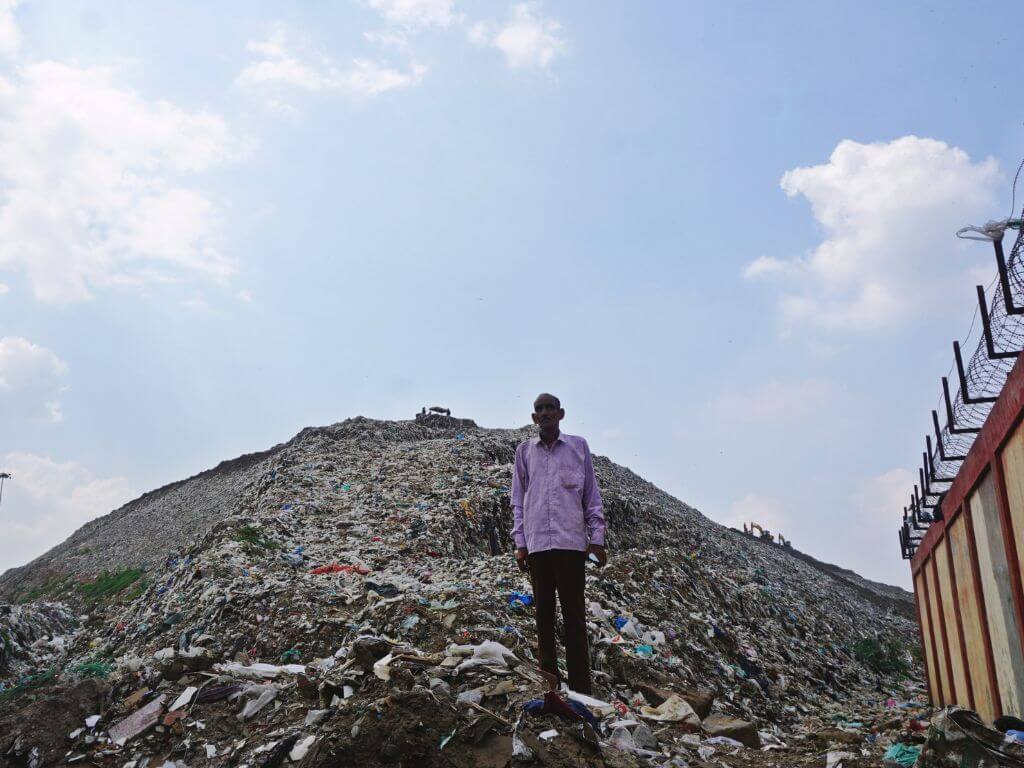Almost as tall as the Qutub Minar in Delhi are the capital city’s towering landfills at Bhalswa, Ghazipur and Okhla. Located in three different corners of the city, they stand testimony to the city’s ‘development’ and worsening air quality, continuing to mount despite the promises to close them.
Having existed for decades, the mammoth mountains of garbage have an overwhelming impact on the lives of those who live around them and those who choose to sustain their economies through them. Mostly migrants and families of workers settle near the landfills, as healthy living conditions are sacrificed for low-rent hovels that pass off as houses. Any talk here of clean air and water, and the right to healthy and sustainable environment, seems like a cruel joke.
The Ghazipur landfill was commissioned in 1984, Bhalswa in 1994, and Okhla in 1996. Over the past three decades, nearly 28 million tonnes of waste have been dumped on the landfills. Various governments have attempted to lay down strict action plans to contain the height of the landfills, yet they continue to rise. As of October 2022, the Ghazipur landfill stands at 65 metres, Bhalswa at 62 metres, and the Okhla landfill at 42 metres, according to Amit Singh, Director (Press and Information), Municipal Corporation of Delhi (MCD).
Statements by the Lieutenant Governor Vinai Kumar Saxena to cut down the height only follow a historically long list of promises made to nearby residents. After being elected as the East Delhi MLA in 2019, cricketer-turned-politician Gautam Gambhir pledged to reduce the height of the Ghazipur landfill, located at Delhi’s border with Uttar Pradesh. While he claims to have brought down the height by 40 feet in 2020, the locals say that the dumpsite continues to expand.
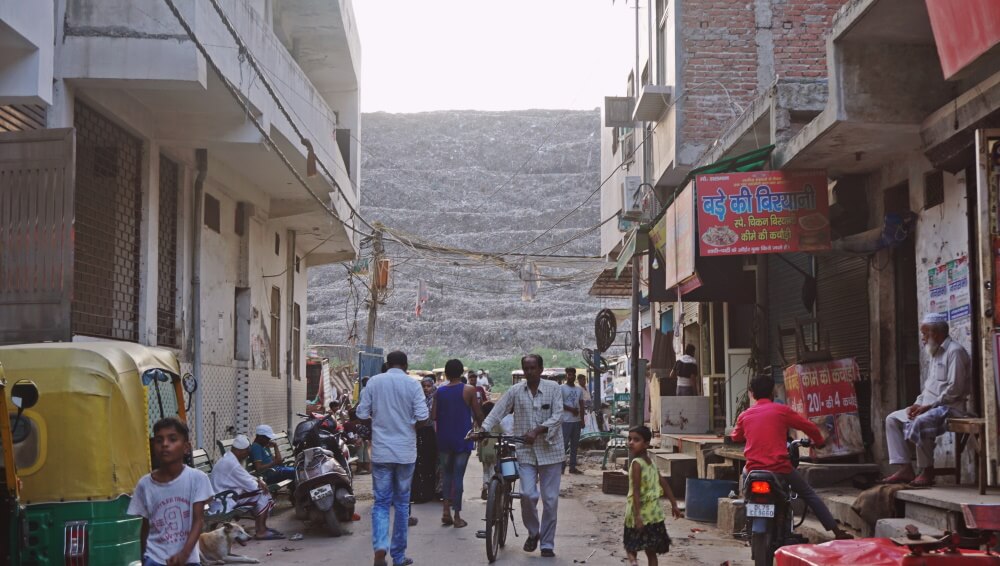
Photo: Priyali Dhingra
With the MCD elections less than a month away, the landfills have come into the limelight yet again. The ruling Aam Aadmi Party (AAP) and Chief Minister Arvind Kejriwal hit out at the Bharatiya Janata Party (BJP) with a campaign titled ‘Kude Par Samvaad’ (conversation about garbage), alleging that in the 15 years that BJP has headed the MCD, the landfills have only grown in size.
Delhi generates over 11,000 tonnes of garbage daily, of which, 6,400 tonnes is dumped at landfills and 4,500 tonnes is sent to three waste-to-energy plants. However, it is this addition of fresh waste to the dumpsite every day that continues to be the key to them soaring high. “The East Delhi Municipal Corporation (EDMC) processes 2,000 tonnes of legacy waste every day, but dumps 2,500 tonnes of fresh waste at the same site. This is a vicious cycle,” says Dr Richa Singh of the Centre for Science and Environment (CSE).
Breathing the toxic air
Rekha Yadav, Rani Sonkar, and Kamlesh moved to the BP Singh Camp in Okhla when they were seven years old. Residing only a few feet away in the camp’s varicoloured lanes since the 1990s, they have seen the Okhla landfill become the mountain it is today. “We have lived here since the landfill was nothing but a large pit. We moved into shanties but made homes for ourselves in the area, and since then, have only seen the landfill’s height rise,” says Kamlesh, adding “You can see all of Delhi from the top.”
All their complaints have fallen on deaf ears. For Sonkar, the constant stench from the landfill is unbearable. “During monsoon, the smell becomes intense. Plastic bags from the landfill often fly into my house and the rain brings its smell deeper into my four walls,” she says.
Like Sonkar, many living near the Ghazipur, Bhalswa and Okhla landfills have learned to live with the foul smell. Pashupati Yadav, a resident of Bhalswa Dairy near the landfill, finds it suffocating. “We choke but we have no other place to go,” he says. A factory worker in Shahbad Dairy, Yadav has been walking around with a mask on much before Covid-19 outbreak. “The monsoon makes it worse for us. My children suffer more than me; the air is unbearable,” Yadav adds.
Yadav and his family live only a few steps away from the landfill, which has often led to garbage spilling over to outside his house. Ever since he moved to the area 15 years ago, he claims to have only seen the landfill’s height rise. “In August last year, a small blast (methane burst) inside the landfill led to garbage coming into my house. Incidents like this keep happening. Our street gets filled with garbage and we only end up cleaning it,” he adds.
As per a study by the Heart Care Foundation of India and Dainik Bhaskar group, living next to a landfill in Delhi leads to more significant health problems. The levels of PM2.5 and PM10, which point to the toxicity in the air, were found to be much higher in the areas next to the landfills. The height and weight of residents were lower and the water samples showed more toxins as compared to that of areas far from the landfills.
Yadav and his wife Meera also recount the recent fire at the Bhalswa landfill which lasted over 10 days, and it took weeks for the smoke to dispel. “It was impossible to live here without covering your face and counting every breath. Some of our neighbours left for their hometown, but those who stayed were the worst sufferers,” Yadav adds.
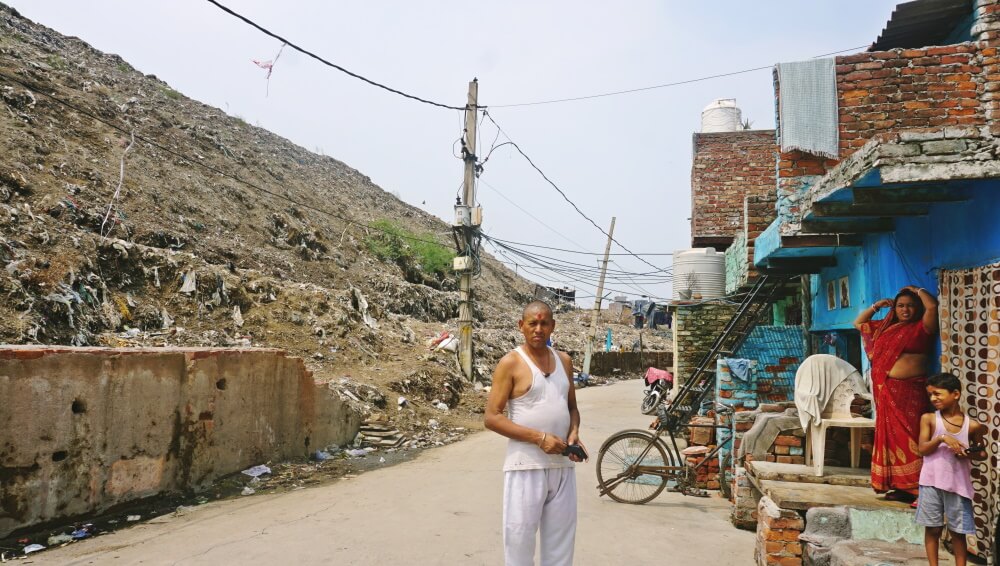
Photo: Priyali Dhingra
The fires within
The 10-day fire at the Bhalswa led to a considerable rise in pollution levels, pushing the city’s pollution to the ‘poor’ category only 24 hours after the incident. The Ghazipur landfill reported three major infernos this summer. Garbage burning is one of the worst polluters in the city.
As per the Indian Biogas Association, overflowing and on-fire landfills contribute to the poor quality of air. A potent greenhouse gas, the methane produced in these landfills is an underreported issue, they said in a submission to the Delhi government. Controlling the toxic fumes from the landfills is also necessary to curb the air pollution menace in the capital.
Much like at Bhalswa, residents of Ghazipur Dairy live near the Ghazipur landfill. Dairy workers and shanty residents here also complain about garbage pieces flying into their homes, especially during the monsoon.
“We live in perpetual fear as piles of garbage can enter our homes anytime,” says Rahman Malik, who moved to the area about a year ago. He adds that while there has been some reduction in the landfill’s height on one side, more garbage is now dumped on their side of the landfill.
The smell from the landfill and its proximity to the homes at the Ghazipur Dairy only add to the residents’ woes. The lanes emanate a strange smell, a mired combination of animal excreta, fodder, and the garbage atop the landfill itself.
Another concern among those living next to the landfills is water. At the Okhla and Ghazipur landfills, residents often get yellow water supply from the pipelines. A resident at the BP Singh Camp, Puneeta, shows the buckets of water lined up outside her house. “Water is the worst part of living here. It’s not just drinking that’s harmful, we can’t even use it to bathe or clean utensils. It makes our skin itch.” Many are forced to spend Rs40 to Rs 60 every day to buy bottled water.
Various reports have shown that the landfills have contaminated the ground water in the area.
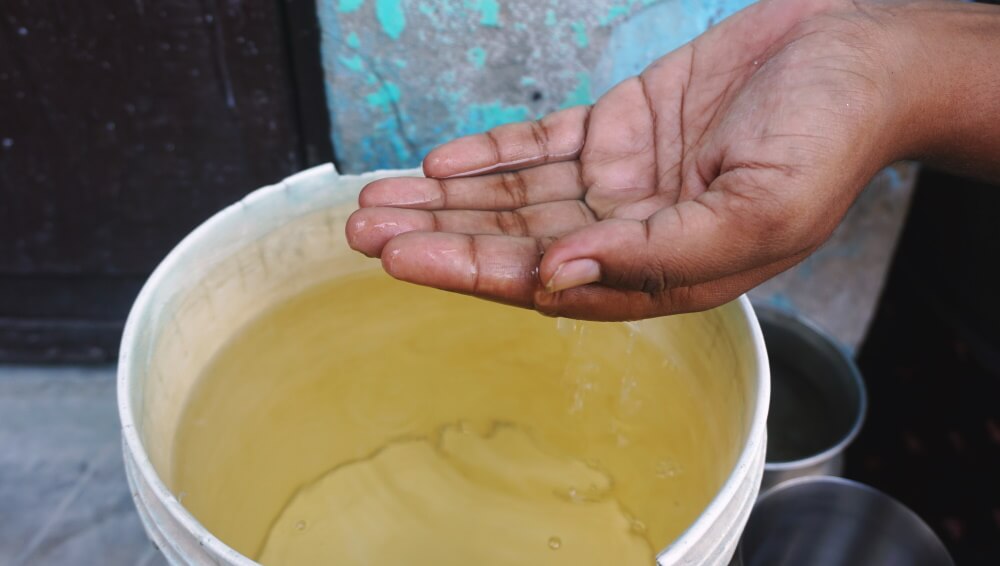
Photo: Priyali Dhingra
Groundwater pollution and human health risks caused by leachate leakage have become a worldwide environmental problem, and the harm and influence of bacteria in leachate have received increased attention… drinking groundwater polluted by heavy metals (such as manganese and arsenic) in leachate for a long time will increase the risk of cancer and infant death, as well as induce motor and cognitive dysfunction in children.[1]
Revenue for ragpickers
Reports of remediating the landfills have often raised alarms for labour rights activists. Apart from being a dump site, the landfills also serve as a source of income for ragpickers in the area. Hailing from underprivileged castes and living in dedicated colonies close to the landfills, the ragpickers, who often happen to be minors, collect reusable material from the landfill on a daily basis. According to EJ Atlas, over 1,500 waste pickers frequent the Ghazipur landfill and use it as a source of income.
“This mountain is all we have, our only form of livelihood,” an 11-year-old Neeraj says as he packs his mount of collectibles from the landfill on a rickshaw. He has been working as a waste picker for about three years now and is the only one in the family to earn money. “My father, a construction labourer, lost his job during Covid and has been unable to find any work. My mother stays at home to take care of my younger sister,” he adds.
Under the Swachh Bharat Mission 2.0, Delhi has been provided the target of December 2024 to process the legacy waste in all of its landfills and complete the remediation procedure. But this puts to risk the lives of many like Neeraj who continue to be the sole bread earners of their families.
At Bhalswa, 21-year-old Hameed can be seen climbing the landfill in peak afternoon hours. Surrounded by large bags of usable items picked by his fellow ragpickers, Hameed shows his hands, victims of skin allergies due to years of waste-picking. “This landfill has provided food on my plate for six years now. If it shuts down, I will have nowhere to go,” he says.
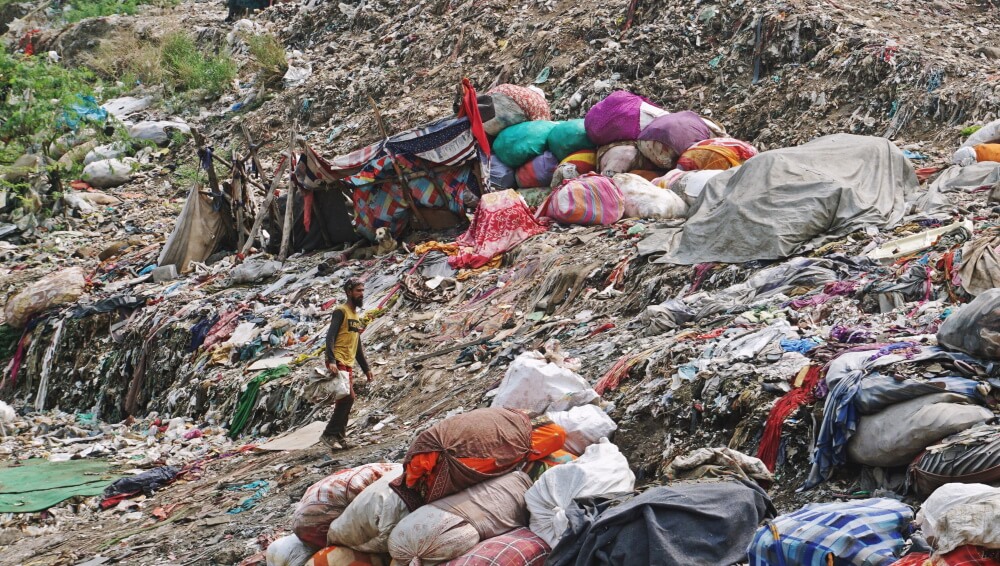
Photo: Priyali Dhingra
Revisiting the quagmire
The landfills cast a poisonous shadow over residents of its colonies, affecting their health and social lives in uncountable ways. According to CSE’s Dr Richa Singh, the capital’s administration needs to take a few stringent steps to move faster towards remediating the landfill.
“All the landfills receive ounces of fresh waste every day, making the processing of legacy waste a moot point. Legacy waste remediation and fresh waste management should complement each other. It is important to invest in technology to process fresh waste. The fraction of waste that is recyclable must be channelled through recyclable procedures. If 50 per cent of Delhi’s daily garbage is considered as organic, it can be treated by installing a bio-methanation plant and converting organic waste into BioCNG,” she says.
Stressing that the condition of Delhi’s landfills is a “complete disaster,” Singh adds that the Solid Waste Regulation Guidelines of 2016 say that recycling should be the first step. “Only the items that cannot be treated should be dumped at the landfill, unlike what we do right now. Landfills are scientifically designed structures but ours don’t even have any barriers or mechanisms for the treatment of leachate (hazardous water that can seep through waste and contaminate groundwater).”
After visiting the 65-metre-high Ghazipur landfill soon after his appointment in May, the LG instructed officials to regularly put out the height of the landfills in the public domain and urged to find concrete solutions to this Herculean problem. Fires at the landfills have caused Delhi’s administration about Rs500 crore in damages. Ever since 2019, landfills in the capital have seen 31 instances of fire. This does not include methane bursts that happen once every few weeks. “Fires at the landfills can be avoided by ensuring sustainable operations. At the end of the day, a 10-centimetre-thick soil cover must be put over the garbage. It can act as a fire extinguisher and separate waste from toxins,” Dr Singh says, adding that piling up waste leads to air voids, which can accumulate methane. She also stresses on the need for individuals to segregate their waste into wet and dry, while ensuring that the same is followed by waste collectors.
Many residents of the colonies near Ghazipur, Bhalswa, and Okhla landfills seem to have lost hope as clearing up the garbage mounds remains a mere political slogan. And with municipal elections in the capital on the horizon, residents are wary of the promises.
Priyali Dhingra is a multimedia journalist based in New Delhi with an interest in visual storytelling. She reports on issues of gender, labour, politics, environment and urban inequality in New Delhi and Hyderabad.

